The ExoLance project and the search for life on Marsby Joe Cassady
|
| ExoLance aims to address the search for current life on Mars by providing frequent flight opportunities to a variety of locations and by delivering the science payload to the region where most scientists believe the best chance is of finding life: below the surface. |
More recently, however, as we ventured out into the solar system with our robotic probes, Mars came to be regarded as a dead planet. A dead planet, perhaps, but one that nevertheless maintained a tenuous atmosphere of carbon dioxide and enough seasonal variation to cause massive freeze outs of the atmosphere to create polar caps. As the capabilities of our probes improved, we learned more and more about this “dead” world, until we began to question again whether Mars ever could have supported life, or even more intriguingly, might support life today.
One such experiment to detect the presence of life was aboard the Viking landers in the 1970s. The results, which were interpreted by some as indicating the presence of life, ignited a debate which continues to this day. However, in the more than 35 years since Viking, no NASA mission has been sent to Mars with a life detection payload.
At Explore Mars, Inc., we believe it is time to change that reality. That is why we are launching the ExoLance project. ExoLance aims to address the search for current, or “extant,” life on Mars by providing frequent flight opportunities to a variety of locations and, most importantly, by delivering the science payload to the region where most scientists believe the best chance is of finding life: below the surface, where the effects of radiation bombardment and oxidation are mitigated.
We achieve this by taking advantage of other missions going to Mars. ExoLance is small and can ride along as a secondary, piggybacked payload on other missions planning to land on Mars. In fact, our goal is to have several ExoLances deployed during the entry, descent, and landing (EDL) phase of missions similar to NASA’s Mars Science Laboratory. By deploying in this way, we can get a wide dispersion over a large area for sampling purposes. The second aspect—getting below the surface—is accomplished by using technology originally developed for military applications to penetrate the surface and deliver the science payload to a depth of one to two meters. These penetrators can take advantage of the excess kinetic energy of the main vehicle at their release; as such, they require no propulsion or other complex systems themselves. We simply let them use that excess energy to impact the surface of Mars. And break in two. On purpose.
| Many other science investigations may also be interested in increasing the frequency and dispersion of their instruments on, or slightly beneath, the surface of Mars. |
The penetrator and the science payload will bore into the surface and end up at the end of a tunnel that is one to two meters deep, down where any Martian microbes are most likely to be happily living. The back half, or aft body, stops at the surface because we need the radio equipment and the power sources to be able to see the Martian sky. In between, a small cable tether feeds out as the probe impacts, connecting the payload to the radio and power.
This idea was already demonstrated by the JPL Deep Space 2 team in the 1990s. It was tested successfully several times in New Mexico before the Deep Space 2 probes were launched as secondary payloads on the Mars Polar Lander mission. Unfortunately, both Mars Polar Lander and Deep Space 2 experienced mission failures, so we did not receive data from the probes on Mars. However, we believe that the engineering work done by the Deep Space 2 team provides us with a very good starting point on which to build for ExoLance.
Explore Mars is also launching a crowdfunding campaign to get the ExoLance project started. Our near- term goals are to use the expertise and design knowledge of penetrator technology to prove the concept and to build a prototype that we can test by firing it into simulated Martian soils at the range in New Mexico. We will then take that design information and apply it, together with other engineering work on the design of the aftbody, into an overall ExoLance integrated vehicle. And as we progress forward with the design, we are going to continue to talk with the project offices of the planned Mars lander missions to ensure that we are considered as potential piggyback payloads.
While the main intent of Explore Mars is to jump-start the search for life on Mars with ExoLance, many other science investigations may also be interested in increasing the frequency and dispersion of their instruments on, or slightly beneath, the surface of Mars. Seismic and thermal monitoring is an example of another area that could benefit from these types of probes. Once ExoLance is developed, we anticipate that it could see a whole variety of uses, some of which may even be back here on planet Earth!
